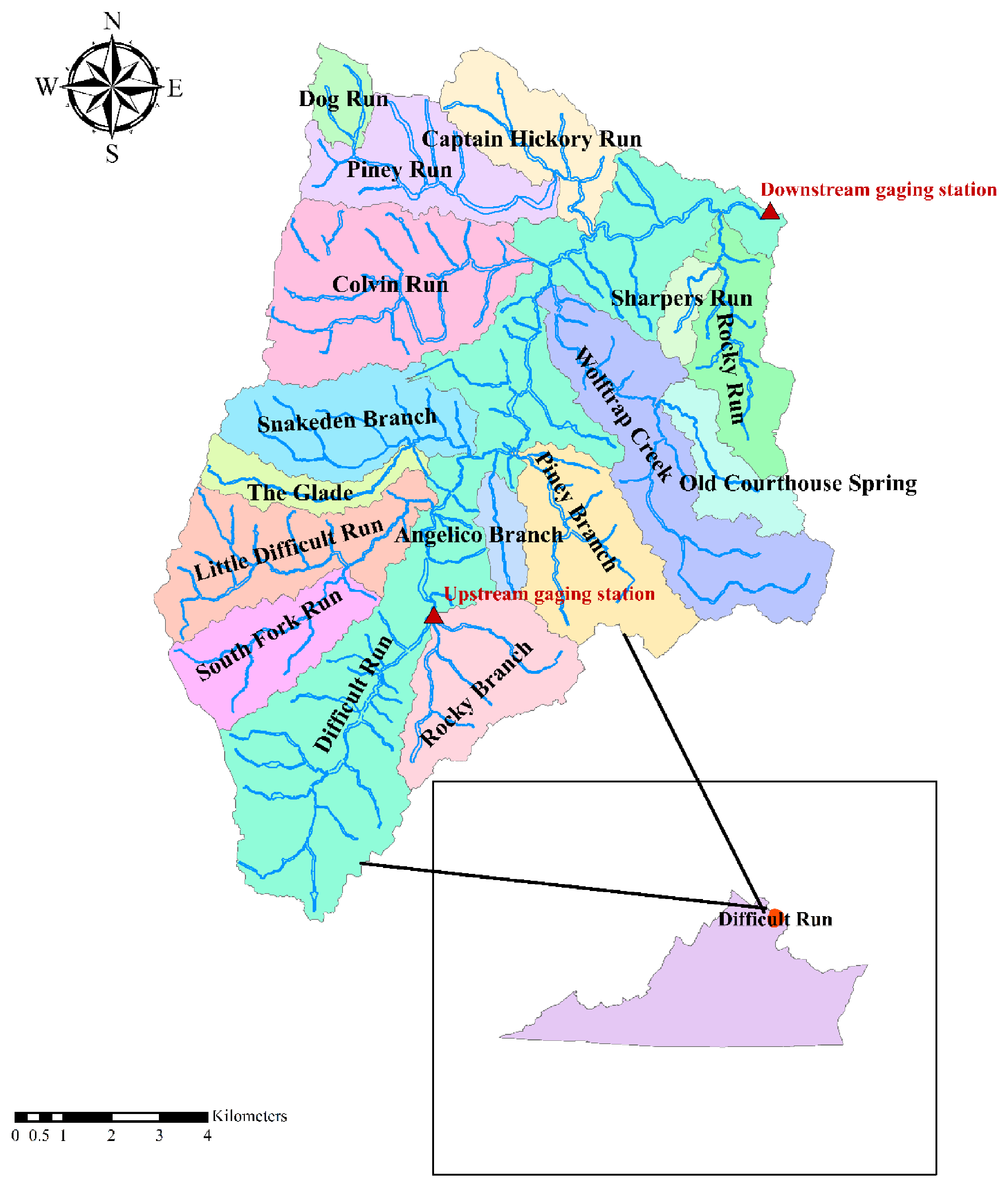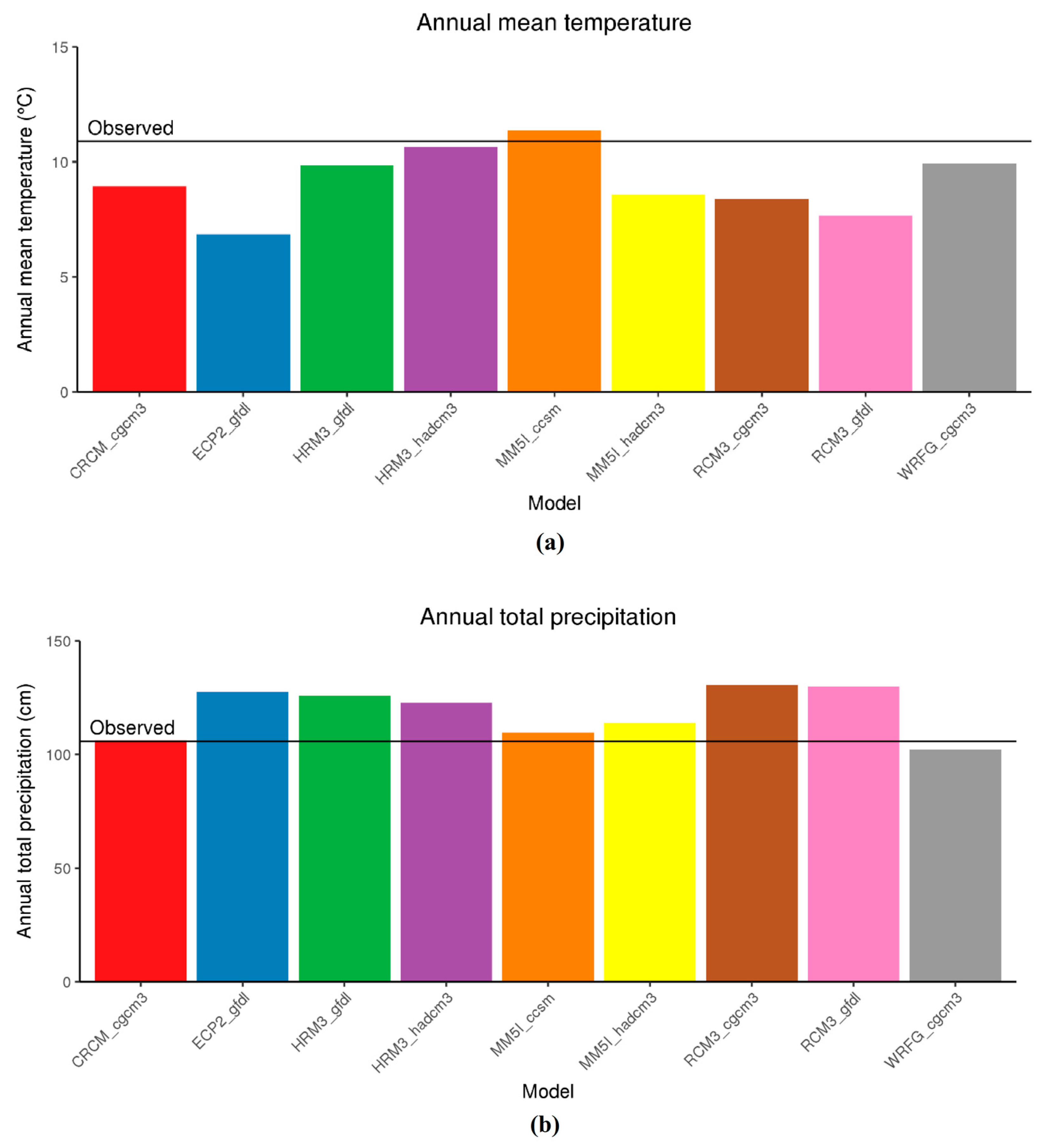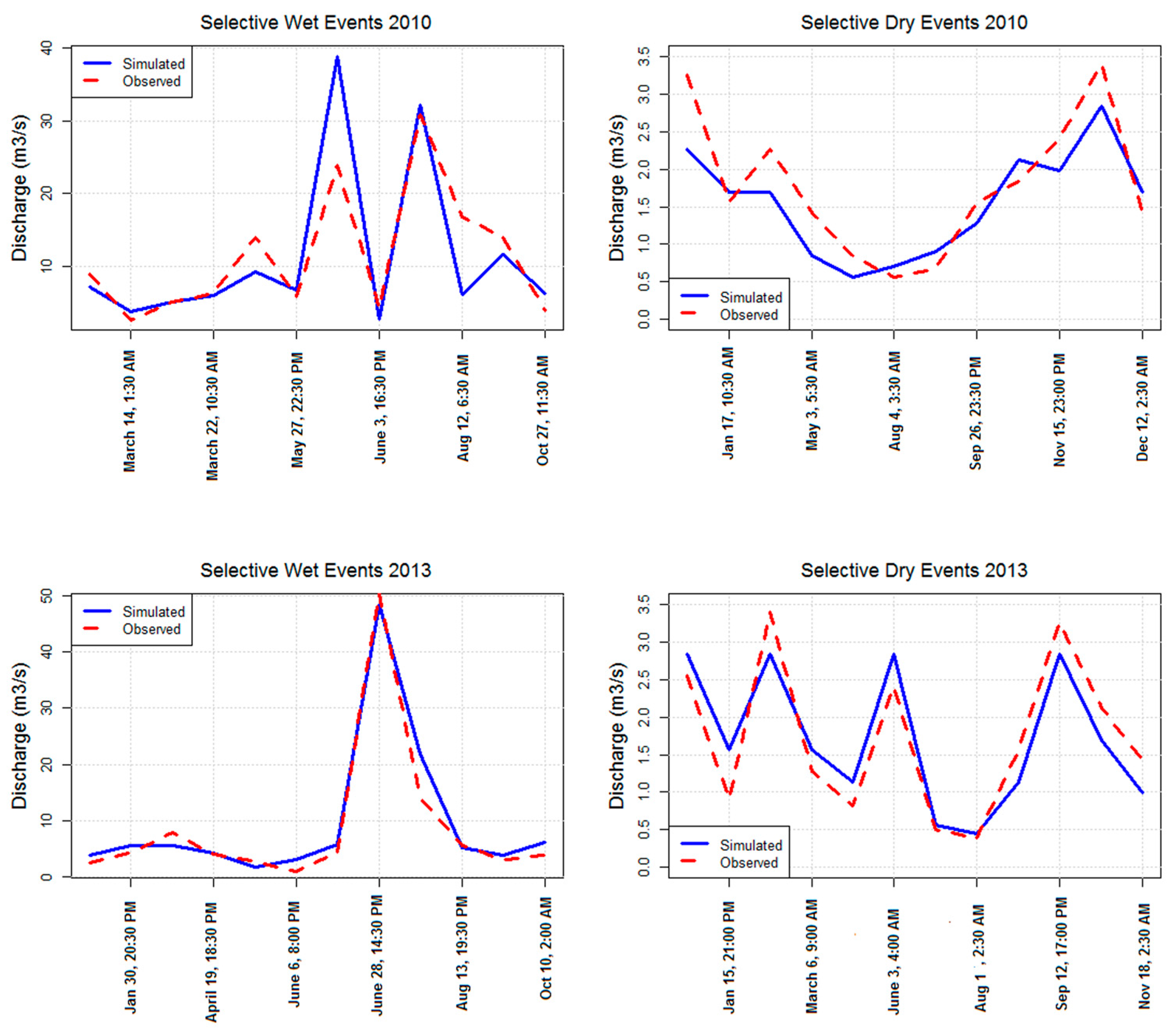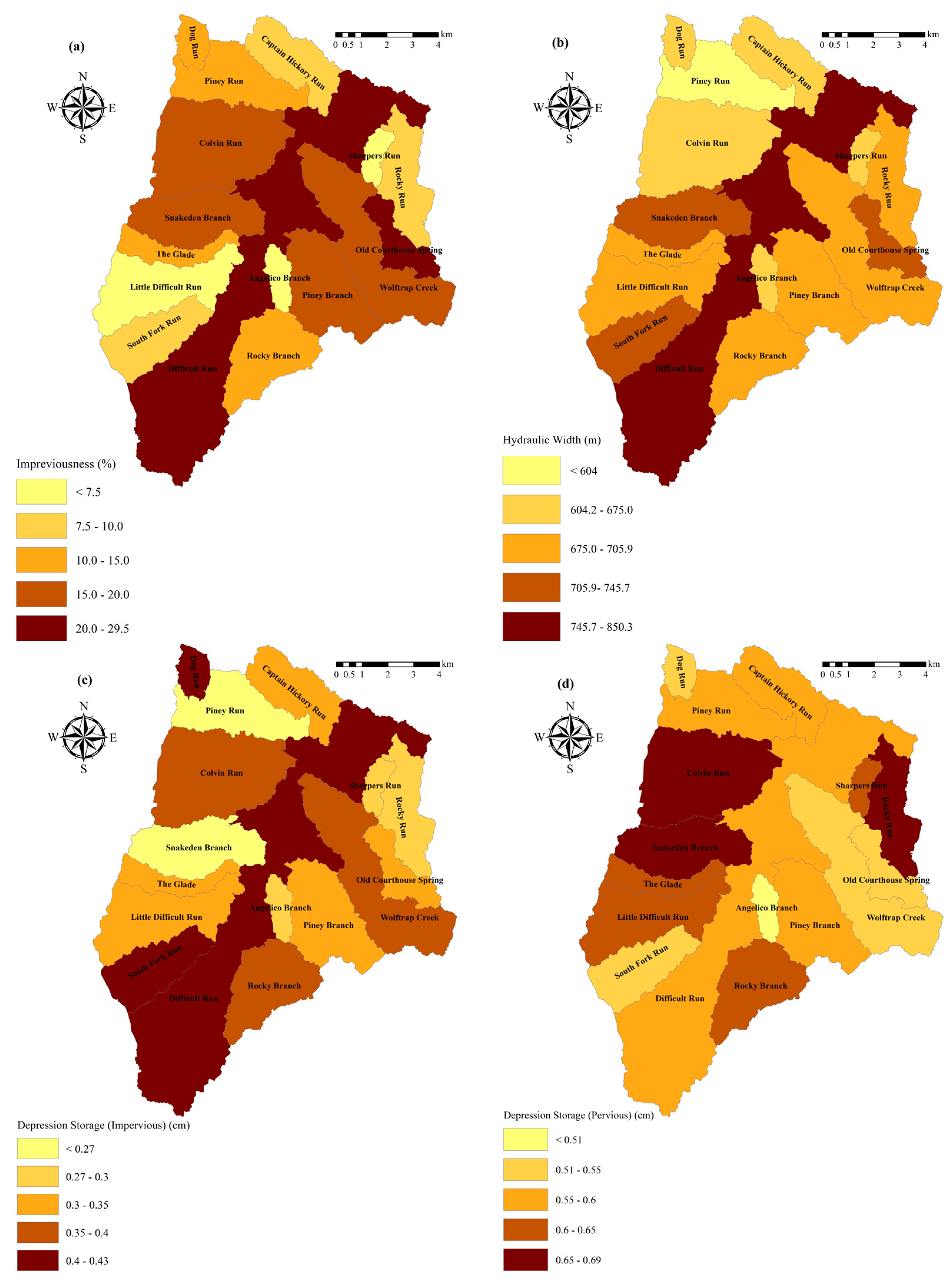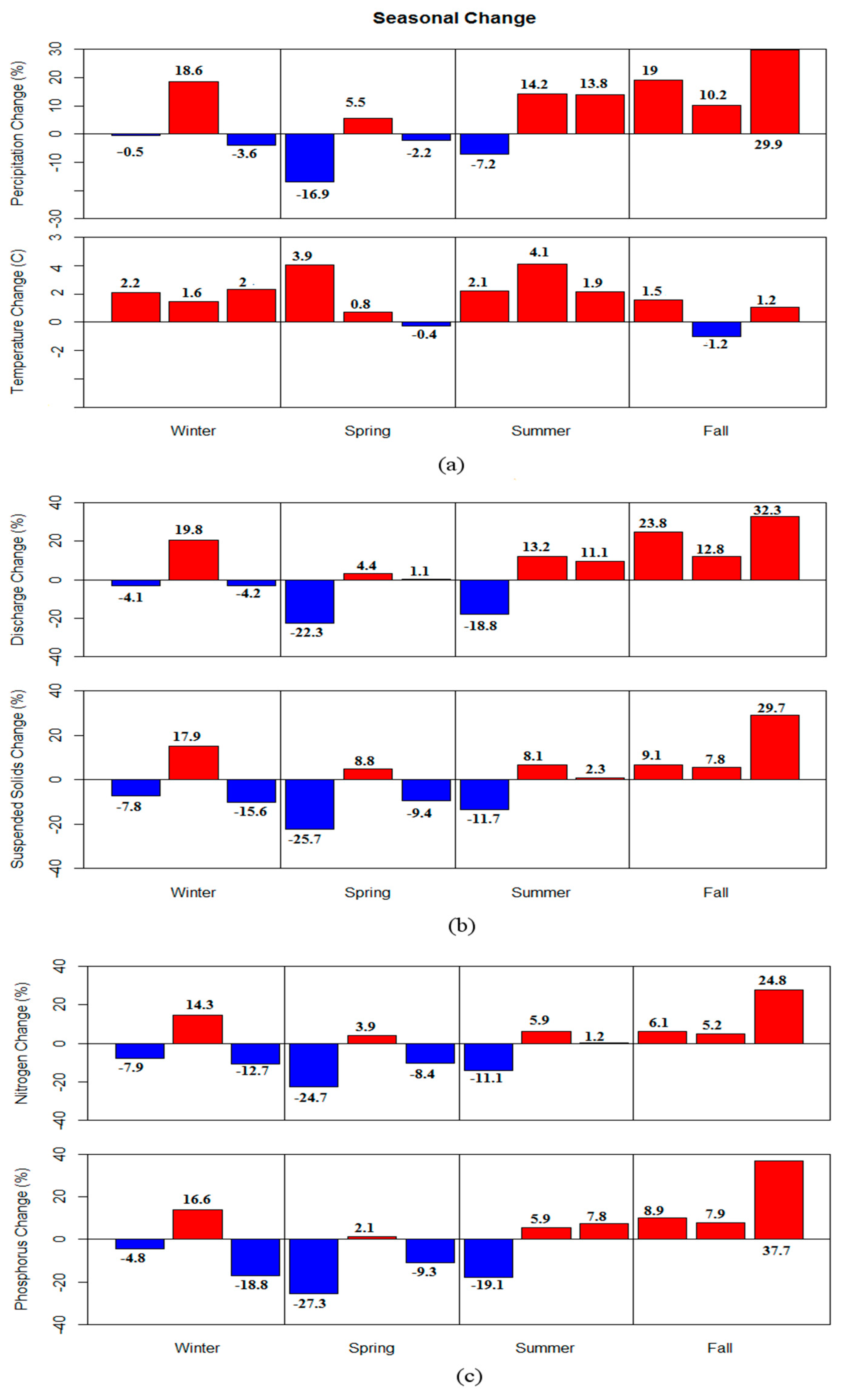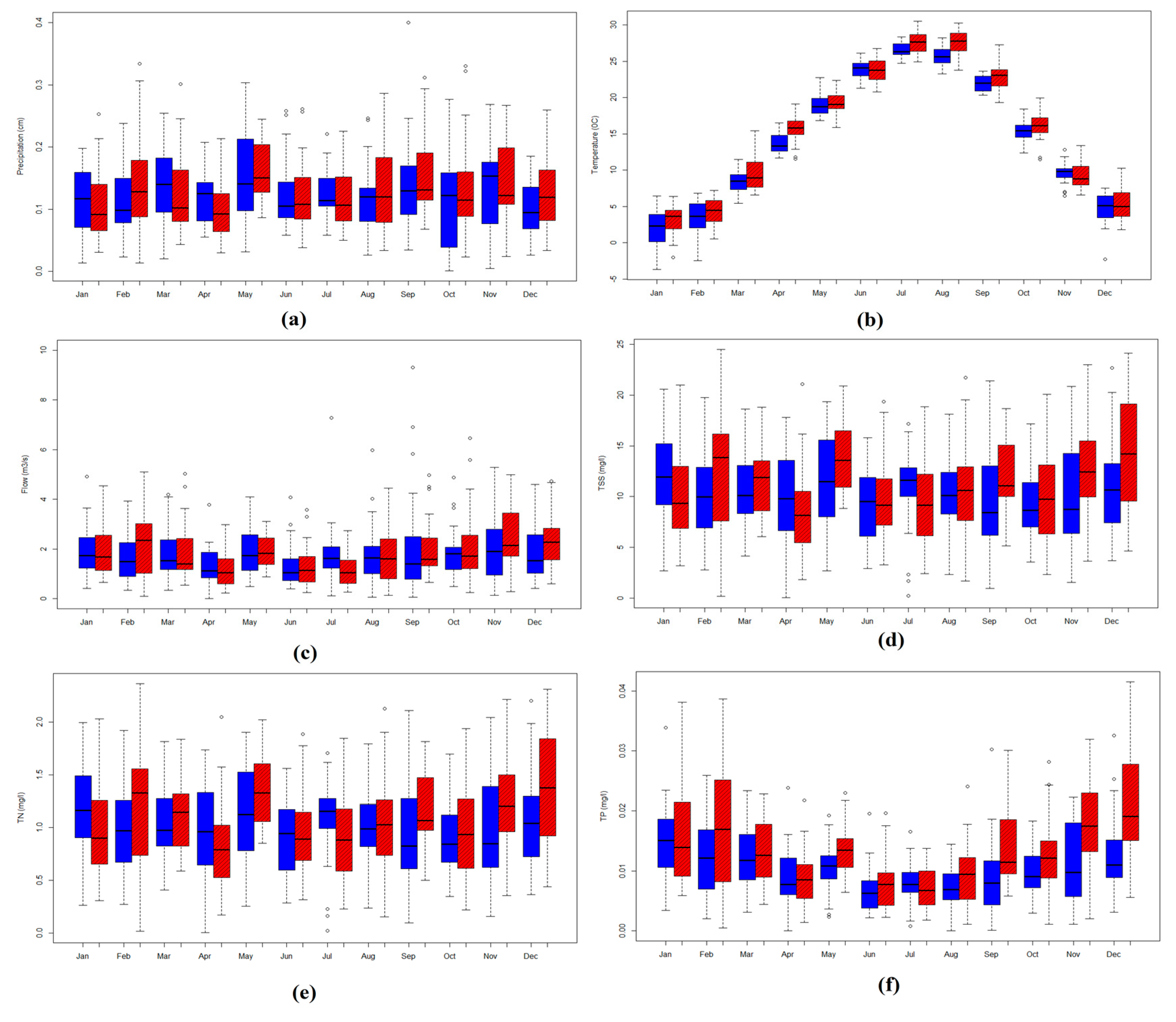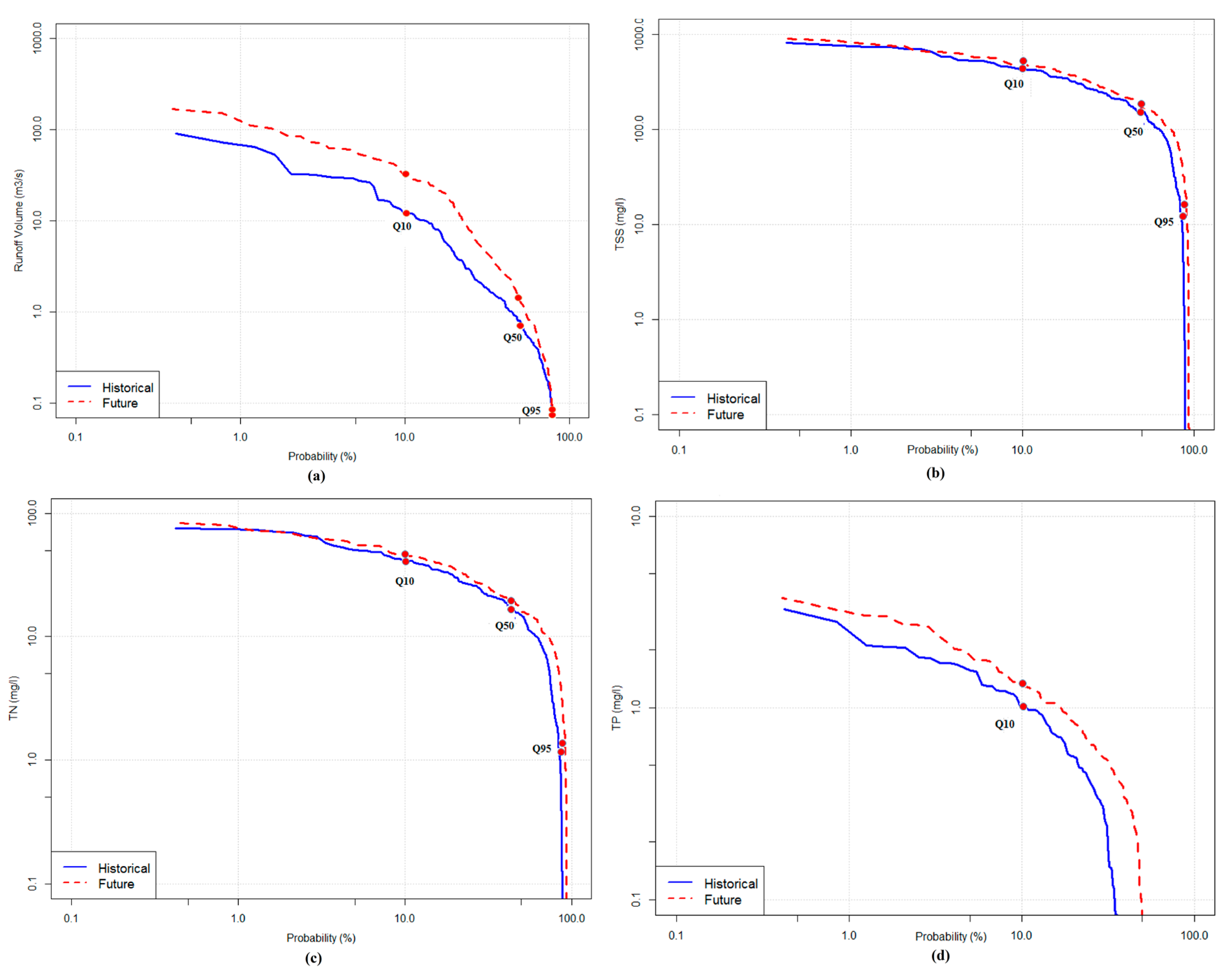1. Introduction
Historical evaluations of the U.S. climate (1950–2009) revealed significant temperature increases for nearly all US cities, which was attributed to climate change (CC) as opposed to “heat island” effects caused by urban development [
1]. Nearly 30% of the urban areas exhibited a significant increase in extreme precipitation. Hayhoe et al. [
2] predicted an increase in precipitation during winter and spring under higher and lower emissions by the end of the 21st century. Najjar et al. [
3] found that, in the mid-Atlantic region, precipitation magnitude and intensity, CO
2 concentrations, sea level, and water temperatures are likely to increase by the end of the 21st century. These predicted increases in rainfall magnitude and intensity could cause infrastructure failures due to increased runoff volumes and rates [
4,
5,
6,
7], overwhelming systems designed for much less. Limited studies using design storms and intensity-duration-frequency (IDF) curves have been conducted to assess the relative impact of CC on stormwater infrastructure. For example, Madsen and Figdor [
8] found that CC in the mid-Atlantic region would increase the frequency of a one-year return period storm to 7.7 months. Moglen and Rios Vidal [
9] used intensity-duration-frequency (IDF) curves generated from regional climate models (RCMs) to assess impacts from urban development and CC and concluded that the impact on infrastructure from each was roughly equivalent. Peck et al. [
10] used a non-parametric weather generator to develop IDF curves for CC scenarios and found significant increases in anticipated precipitation intensities. Collectively, these studies provide a first assessment of what could be a major impact of CC, increased flooding of urban areas, which will require significant efforts, both financial and regulatory, to address [
11].
More complex methods have been conducted using continuous simulation modeling incorporating altered climate predictions produced by a global climate model (GCM) and/or RCMs. Unfortunately, GCMs lack the spatial and temporal resolution for application to urban watersheds, and while the spatial resolution of RCMs (50 km
2) is acceptable, they cannot achieve the sub-hourly temporal scales necessary to simulate the flashy urban runoff response [
12]. Downscaling is a method used to bridge the mismatch between the spatial resolution of GCMs and RCMs and the required resolution for assessment of the CC impacts [
13]. Two widely used downscaling methods are dynamical and statistical downscaling. Systematic errors are inevitable in RCM outputs; therefore, bias correction is often necessary after downscaling to a higher spatial resolution. Biases may occur in the climate model outputs due to a coarse spatial resolution, simplified processes, or numerical diffusion inherent in any model. Such errors can affect the projected results and should be corrected before using any climate model [
14]. Wood et al. [
15] reviewed six methods for generating future precipitation data for use in runoff modeling, consisting of three statistical downscaling methods: linear interpolation (LI), spatial disaggregation (SD), and bias-correction and spatial disaggregation (BCSD) applied to either the Parallel Climate Model GCM (PCM) or to the output after using a RCM to downscale the PCM. The authors found that the BCSD applied to the dynamically downscaled RCM was able to reproduce observed weather and provided the most plausible results compared to historical data. Teutschbein and Seibert [
16] compared linear scaling, local intensity scaling, power transformation, variance scaling, distribution transfer, and the delta-change approach, and found that all methods were capable of correcting bias; however, significant differences were apparent between them. Gudmundsson et al. [
17] compared distribution derived, parametric, and nonparametric transformation methods for correcting bias of RCM outputs. The results indicated that nonparametric transformations were best at reducing bias in RCM outputs. Lafon et al. [
18] compared linear, nonlinear, γ-based quantile mapping, and empirical quantile mapping for reducing bias in RCM precipitation output. The results revealed that the third (skewness) and fourth (kurtosis) moments were sensitive to the choice of bias correction method, and the γ-based quantile-mapping technique performed significantly better than other methods. Linear scaling, local intensity scaling, daily translation, daily bias correction, quantile mapping based on an empirical distribution, and quantile mapping based on a gamma distribution were compared by Chen et al. [
14] to reduce bias from RCM outputs driven by North American Regional CC Assessment Program (NARCCAP) data. The results indicated all methods improved RCM output. Chen et al. found the calibration performance of a hydrological model was influenced by bias correction method and watershed location.
Rosenberg et al. [
19] compared historical hourly precipitation data sets from Washington State from 1970 to 2000 to a generated dynamically downscaled data set from 2020 to 2050 and output from a weather generator from several GCMs, and used these data to estimate streamflow. While few areas showed statistically significant differences in streamflow, the authors caution that improvements in downscaling methods for RCM outputs need to be made before results could be generalized sufficiently for drainage design. Recently, Wang and Chen [
20] developed and tested a bias correction method using a modified version of equiratio cumulative distribution function matching. This method corrects model data using multiplicative scaling factors and improves the equidistant approach in bias correction of precipitation and enhances its performance. A modified version of this method was used for downscaling RCMs in this paper.
A variety of models are available for simulation of runoff, including Win TR-55 [
21], Hydrologic Engineering Center Hydrologic Modeling System (HEC-HMS) [
22], Mike-Urban [
23], and the U.S. Environmental Protection Agency’s (EPA) Storm Water Management Model (SWMM) [
24,
25]. HEC-HMS, Mike-Urban, and SWMM have the capability of being used in both event-based and continuous simulation modes [
26,
27]. Of these three, HEC-HMS and SWMM are in the public domain. SWMM is widely applied for continuous rainfall-runoff simulation in urban areas [
28,
29,
30]. SWMM simulates surface runoff, infiltration, evapotranspiration (ET), snowmelt, surface water routing, surface water storage, groundwater, water quality, and treatment processes. SWMM is able to simulate the production of pollutant loads associated with runoff through modeling buildup and washoff processes from specific land uses during dry weather and storm events, respectively [
31].
Urban development creates large amounts of impervious surfaces for roads, parking, buildings, and sidewalks. As impervious surfaces are created, large increases in runoff volume and rates occur. SWMM has been applied to evaluate the combined hydrologic impacts of urbanization and CC [
28,
32,
33,
34]. Few studies were found addressing water quality impacts from CC in urban areas at the watershed scale. Hydrologic changes from urban development cause erosion from landscapes and streambanks, as well as channel scour and degradation [
35,
36]. Runoff mobilizes pollutants such as metals, nutrients, and toxicants [
37], affecting streams, lakes, rivers, and estuaries as runoff is transported downstream. Elevated nutrient levels contribute to aquatic “dead zones” affecting many estuaries worldwide, perhaps the most notable example being the Chesapeake Bay [
38]. To address deterioration of the aquatic health of the Bay, the U.S. EPA established a Total Maximum Daily Load (TMDL), restricting nitrogen (N), phosphorus (P), and sediment in discharges to each tributary of the Chesapeake Bay [
39]. The objective of the TMDL is to reduce N, P, and sediment loadings by implementing stormwater control measures (SCMs), also known as best management practices (BMPs), to reduce runoff or N, or P, and/or sediment loading. CC impacts temperature, precipitation, and other climatic variables (wind speed, humidity, solar radiation, and etc.) [
40,
41], leading to changes, often reductions in SCM effectiveness [
42]. N, P, and sediment export from the landscape to surface waters are controlled by the combination of key biogeochemical processes driven by hydrologic transport. When the potential impact of CC variability is added to the system, critical biogeochemical processes will be altered across the Chesapeake Bay watershed [
43]. A better understanding of these coupled processes is critical to managing N, P and sediment exports from the Bay watershed to the estuary from urban and agricultural systems; this paper focuses on the urban contribution to watershed loading for N, P, and sediment. Improving the ability to predict CC impacts on water quality in urban watershed is needed to evaluate conditions and select the best treatment options.
The objective of this study is to evaluate the impacts of CC on an urban watershed including the impact on runoff volume, peak flow, and water quality (Total Suspended Solids, TSS; Total Nitrogen, TN; and Total Phosphorous, TP), using a SWMM calibrated with a robust autocalibration tool, R for Storm Water Management Model (RSWMM), developed within the R environment. Hourly precipitation data from a mid-range emission scenario and regional climate model are used to force the SWMM model. A multi-objective optimization package, the Non-dominated Sorting Genetic algorithm (NSGA-II) was incorporated into RSWMM, providing functions for box-constrained multi-objective optimization using a genetic algorithm. A postprocessor for classifying output into events and plotting probability of exceedance curves of user selected outputs was incorporated for ease of comparing scenarios. As a case study, the tool is applied to the calibration of a previously developed SWMM model of the Difficult Run watershed in Fairfax County, Virginia, which is tributary to the Chesapeake Bay, using historical and downscaled projected precipitation and temperature data. This new and novel method will then be used to assess the impact of CC on predicted water quality from the watershed.
4. Conclusions
A hydrologic/hydraulic/water quality model (SWMM) was used to simulate a continuous rainfall-runoff response in an urban watershed, Difficult Run, Fairfax, VA. The model was then calibrated to observed conditions for peak flows, runoff volume, and water quality using two gauging stations in the watershed. The calibrated model was verified by assessing its performance against historical data. After calibration and verification, the impact of CC on the runoff volume and water quality in the watershed was assessed using downscaled precipitation and temperature data. Recent simulations from the NARCCAP were adapted for this purpose, using dynamic downscaling. The hydrology of the Difficult Run watershed was then simulated using SWMM, with the assistance of RSWMM for calibration, event processing and exceedance curve plotting for historical and future conditions. The following conclusions can be drawn from the study:
Three SWMM parameters, including hydraulic width, imperviousness, and depression storage, were altered during calibration. Hydraulic width and imperviousness were the most sensitive parameters affecting peak flows.
NARCCAP and other dynamically downscaled model datasets are particularly useful for hydrological modeling because they provide downscaled data for all of the necessary variables from multiple global and regional models and are openly available online. Dynamical downscaling of the CMIP5 models is being performed by the North American Coordinated Regional Climate Downscaling Experiment (NA-CORDEX), but this project is not yet complete. Temperature and precipitation data from NA-CORDEX have been recently published, but other data that are needed for hydrological simulations, such as wind speed and radiation, are not yet available. Thus, the NARCCAP dataset is still the most current set of complete downscaled model data for our study area.
The hydrological impact of the CC projection indicates that the mean annual runoff is predicted to increase by 6.5%, and TSS, TN, and TP are predicted to increase by 7.66%, 6.99%, and 8.1%, respectively. Statistically, only projected TP loads were significantly different than historical TP loads.
The simulation results demonstrate that the mean, median, maximum, and the range between the 10th and 95th percentiles were projected to increase in the future with CC conditions. The interannual variability in the future is also projected to increase.
Q10, Q50, and Q95 were compared using exceedance probability curves. Results show that these flow statistics are projected to increase in the future with CC; the greatest difference occurred at the 10th percentile for runoff volume.
The limitations of this analysis stem from the sources of uncertainty, which include: uncertainty in GCMs, including their inherent assumptions regarding future emission of greenhouse gases, uncertainty in the representation of climatology at regional and local scales, and uncertainty of parameters required for input in development of hydrological models. Analysis of uncertainty propagating through the multiple models and processes covered in this study was beyond the scope of this case study, but is a research recommendation. A key limitation of the case study analysis is the use of a single greenhouse emission scenario. However, the contribution of this paper is its development of methods for water quality modeling of an urban watershed subjected to CC. Methods used in this paper can be extended to incorporate a wide range of CC models.
Understanding CC effects on water quantity and quality in urban watersheds will help water resource managers and planners make better decisions in managing water resources issues. Studies such as these can assist them as they evaluate the complex physical, social and economic impacts of CC on urban communities. In addition, making predictions of the impact of CC will help improve the management of stormwater systems to reduce flooding and to produce better water quality through appropriate selection of SCMs.
